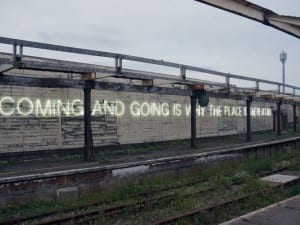The new Ellen Gallagher show opened on Wednesday at the Tate Modern. After last year’s gigantic displays of work of both Damien Hirst and Edvard Munch, it’s refreshing to see a not so publicly known artist on view throughout the gallery’s sprawling rooms. Rather than packing the renowned artist punch, her work was allowed to ramble more freely, showing experimental mixes of collage and video work much looser than the display of a universally recognised artist.
Black culture is the main focus of her work, delving into the myths and stories that surround it, from looking to black pop culture and fashion, to creating mythological fantasies with tumbling seas and dark rituals. Her work first came to prominence in the form of black minstrel faces, cut out and obscured to a point of near on abstraction. The fact that these faces still hold some form of recognition within the new muddled fantasy created on the page show just how these cliches and images are welded on the collective conscious.
Her works with collage and cut outs from magazines and posters are the most interesting, as it is an area that a lot of artists venture into, but that is very hard to create much individuality with. It’s an area that normally is considered too easy to create something that looks slightly interesting, without holding much depth or thought. Gallagher’s layering up of tiny thick facial shapes and comedy boggly eyes create an alluring mix that is both lighthearted and captivating. Demonic eyes cut out from smiling magazine faces create the feeling of being on an especially nasty acid trip whilst flicking through magazines in the hairdressers and she creates an unsettling atmosphere with very little removed from the original image. It is this subtlety that makes her stand apart from many other artists working in a similar style. With collage it is all about exactly where and how you remove or add the smallest alteration and is a fine balance that she understands very well.
Having sprung to prominence in the 90’s she also shows an interesting lack of respect for the idea of high art and mixes it adeptly with absurdity. Her work is high art, and very intelligent high art at that, but she isn’t afraid to throw in a glitter embossed space ship (the brilliant Abu Shimel) or yellow comedy wig every now and then. Pulling together the sinister with the ridiculous, the world created in her works is incredibly individual to her and is a mash up of so many talents and genres that it is hard to put your finger on exactly what it is that she does. This is also the benefit of not being such a star name for such a large show. We are given insight into every part of her practice rather than a carefully selected and controlled direct route. This does fall short at points, and some of the less characterful works, (blocks of muted colours on paper and similar works) don’t hold too many surprises. In other parts this really pays off, as with Osedax, a video installation made with Edgar Cleijne, that features ethereal film projections, a soundtrack that dips to an almost non existent level then ramps back up to a 60’s pulse in parts, and a tiny, half height door to enter through. Again, this gives the subtle feelings of a drug like reality, which is never pushed beyond the odd feeling of discomfort or slight distortion of reality, just enough to call to mind some of the artists of the 60’s and 70’s that dabbled in video and cut outs. This also connects in parts with hair styles and fashion choices of magazines and collages used. It also crosses over with a time at which black culture was shifting heavily. As with all her work this isn’t done explicitly, but immediately the combination of 60‘s culture and black culture call to mind the many social and political issues dragged up by this period. Her springing up in the 90’s has allowed her to begin her work from a truly post modern standpoint, pulling apart the work of those who have previously pulled apart the world and creating a cross referenced and deeply complex set of work in doing so. This isn’t the work of explicit juxtaposition, but of very carefully considered subliminal messaging.
This exhibition is incredibly worth a visit for two reasons. The first being that she addresses her subject matter in such an individual way to many artists who look at black culture and immediately jump on recent and known historical events without too much philosophical questioning into its deeper roots. The second is for her practice as an artist. She is very confident with pulling apart well set ideas and ways of working within the art world. Not in any way to create a buzz or controversy (as could be said of Hirst) but simply to pull it apart and see what lies beneath.
Emily Steer
Ellen Gallagher, AxME, Tate Modern, Bankside, London, SE1 9TG. www.tate.org.uk
Image Ellen Gallagher, Untitled 2012 . Gagosian Gallery. © Ellen Gallagher





